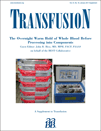Effect of additive solutions on red blood cell (RBC) membrane properties of stored RBCs prepared from whole blood held for 24 hours at room temperature
Abstract
BACKGROUND: The quality of RBC components is influenced by collection, processing and storage conditions. Regulations require that whole blood (WB) units be refrigerated within 8 hours and processed into RBCs within 24 hours of collection. Overnight room temperature hold of WB has logistical advantages, but the effect on RBC quality has not been fully investigated. RBC additive solutions were compared for their ability to provide improved quality of RBCs prepared from WB held at room temperature for 24 hours.
STUDY DESIGN AND METHODS: Leukocyte-reduced RBCs were prepared from WB held at 20°C on cooling plates for 24 hours prior to processing. RBCs were stored in additive solutions, SAG-M (control), Erythrosol-4, and PAGGSM, under standard blood banking conditions and sampled during 49 days of storage. Stored RBCs were evaluated for RBC shape and microparticle (MP) accumulation using flow cytometry. Osmotic fragility, adhesion of RBCs to endothelium under shear stress conditions (0.5 dyne/cm2), and routine RBC quality parameters were assessed.
RESULTS: RBCs stored in Erythrosol-4 and PAGGSM had decreased cell size, reduced osmotic fragility, and decreased accumulation of glycophorin A-positive MPs and annexin V-binding MPs compared with RBCs stored in SAG-M. RBCs stored in erythrosol-4 had increased adherence to endothelium at days 42 and 49 compared with RBCs stored in SAG-M or PAGGSM.
CONCLUSION: RBCs stored in PAGGSM or Erythrosol-4 had improved retention of RBC membrane and osmotic resilience. The development of new additive solutions may offer improved quality of RBC components prepared from WB held overnight at room temperature.




